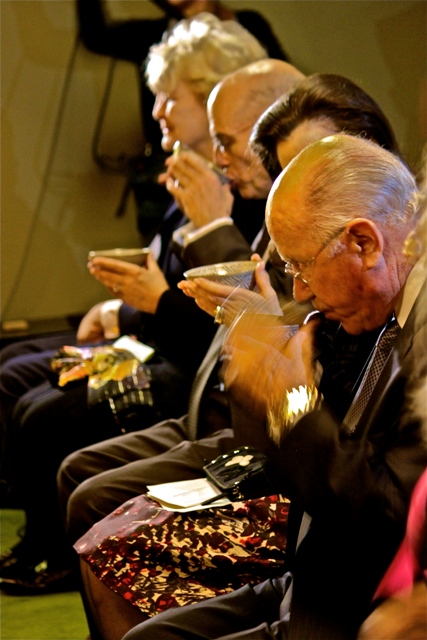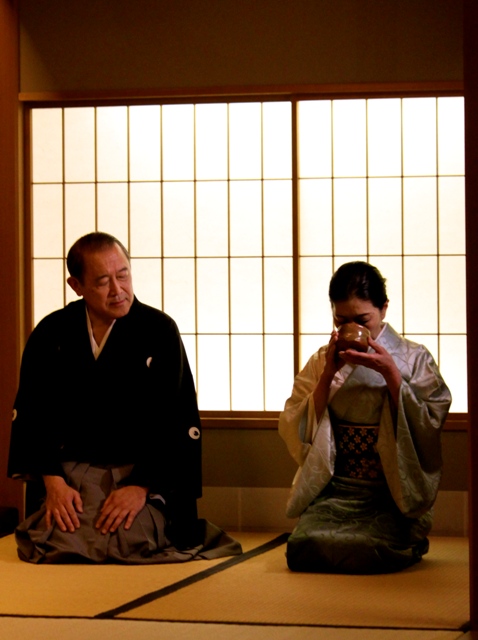Chef Hiroyuki Koga explains the attention to detail necessary for him to create Kougei Gashiand—the specific ingredients sought from all over the world, the artistic aspect of sculpting the dough that takes years to master, and the specific patterns of ingredient combination that result in the different flavors.
Then the guests try to make it for themselves. As Chef Koga walks them through it, the traditional preparation process is reduced to crudely basic language: “now pick up that part… put it in the bowl… press that part down…mash it together with the white part.” But the root of the cultural experience remains valuable, and the guests are then treated to an authentic Japanese tea ceremony in celebration of Hinamatsuri, or Girl’s Day Festival. It was also a celebration, as tea master Sen So-Oku explained, of the future of U.S.-Japan relations.

The guests are assured at the outset of the tea ceremony that they are not expected to cohere to the traditional protocol, as even most Japanese people are hesitant to participate in these ceremonies out of fear that they will have a faux pas. For instance, the guests would traditionally be expected to drink their tea in precisely 3 ½ sips, turning the bowl 90 degrees before they begin and then again when they are finished. “You do not need to be nervous about these things,” it was explained, “because it is really just about drinking the tea.”

Each utensil that is used is not without its significance. Tea master Sen So-Oku, from the Mushakoji-Senke school of tea, explains in great detail the history of every bowl, spoon, ladle, and incense holder seen in the room. The smaller bowl was made in the Korean peninsula in the 16th century and then shipped to Japan. The tea scoop is exceptional because while a tea master will typically make his own, this one was crafted by the wife of the seventh-generation tea master. His English translator implores, “he really wants you all to understand the subtle beauty of the tea ceremony.”
This translated into a beautiful evening of Japanese culture enjoyed by those in attendance, including luminaries such as Secretary Mabus, Mrs. Esther Coopersmith, General James Jones, Mr. Robert Kimmitt, and Mr. William Nitze, to name a few. Ambassador Ichiro Fujisaki and wife Yuriko Fujisaki hosted the evening with the elegance and charm that they are known for. And whether or not the practices remained strictly traditional, the true spirit of the Hina Matsuri tea gathering was still conveyed to all who participated.
Photos are courtesy of the Embassy of Japan.
Captions: Photo 1: chef Hiroyuki Yoga demonstrates the preparation of traditional Kougei Gashi, a dough-like mochi confection that depicts objects in nature. Guests pictured include Holly Sutherland Kimmitt, Mrs. Raymond Mabus, and wife to Ambassador Fujisaki, Yoriko. Photo 2: Ambassador Ichiro Fujisaki watches wife Yoriko drink the tea prepared by Sen So-Oku, the fifteenth heir to the Mushakoji-senke family of tea-masters, as part of the traditional ceremony for Hina Matsuri. Photo 3: The guests participate in the traditional tea ceremony. Pictured in the foreground are Mr. Arnaud de Borchgrave and wife Alexandra Villard de Borchgrave.


a global affairs media network
The Hina Matsuri Tea Gathering—March 2 at the Embassy of Japan

March 14, 2011
Chef Hiroyuki Koga explains the attention to detail necessary for him to create Kougei Gashiand—the specific ingredients sought from all over the world, the artistic aspect of sculpting the dough that takes years to master, and the specific patterns of ingredient combination that result in the different flavors.
Then the guests try to make it for themselves. As Chef Koga walks them through it, the traditional preparation process is reduced to crudely basic language: “now pick up that part… put it in the bowl… press that part down…mash it together with the white part.” But the root of the cultural experience remains valuable, and the guests are then treated to an authentic Japanese tea ceremony in celebration of Hinamatsuri, or Girl’s Day Festival. It was also a celebration, as tea master Sen So-Oku explained, of the future of U.S.-Japan relations.

The guests are assured at the outset of the tea ceremony that they are not expected to cohere to the traditional protocol, as even most Japanese people are hesitant to participate in these ceremonies out of fear that they will have a faux pas. For instance, the guests would traditionally be expected to drink their tea in precisely 3 ½ sips, turning the bowl 90 degrees before they begin and then again when they are finished. “You do not need to be nervous about these things,” it was explained, “because it is really just about drinking the tea.”

Each utensil that is used is not without its significance. Tea master Sen So-Oku, from the Mushakoji-Senke school of tea, explains in great detail the history of every bowl, spoon, ladle, and incense holder seen in the room. The smaller bowl was made in the Korean peninsula in the 16th century and then shipped to Japan. The tea scoop is exceptional because while a tea master will typically make his own, this one was crafted by the wife of the seventh-generation tea master. His English translator implores, “he really wants you all to understand the subtle beauty of the tea ceremony.”
This translated into a beautiful evening of Japanese culture enjoyed by those in attendance, including luminaries such as Secretary Mabus, Mrs. Esther Coopersmith, General James Jones, Mr. Robert Kimmitt, and Mr. William Nitze, to name a few. Ambassador Ichiro Fujisaki and wife Yuriko Fujisaki hosted the evening with the elegance and charm that they are known for. And whether or not the practices remained strictly traditional, the true spirit of the Hina Matsuri tea gathering was still conveyed to all who participated.
Photos are courtesy of the Embassy of Japan.
Captions: Photo 1: chef Hiroyuki Yoga demonstrates the preparation of traditional Kougei Gashi, a dough-like mochi confection that depicts objects in nature. Guests pictured include Holly Sutherland Kimmitt, Mrs. Raymond Mabus, and wife to Ambassador Fujisaki, Yoriko. Photo 2: Ambassador Ichiro Fujisaki watches wife Yoriko drink the tea prepared by Sen So-Oku, the fifteenth heir to the Mushakoji-senke family of tea-masters, as part of the traditional ceremony for Hina Matsuri. Photo 3: The guests participate in the traditional tea ceremony. Pictured in the foreground are Mr. Arnaud de Borchgrave and wife Alexandra Villard de Borchgrave.


